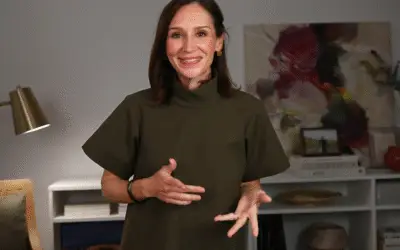#310: The Right Grammar for English Introductions

Have you ever introduced yourself in English and immediately wished you could rewind and try again? Maybe something didn’t sound right. You weren’t sure about the right words, the right details, or the right grammar when introducing yourself in English.
Let’s make sure that never happens again.
Whether you’re starting a conversation at a friendly party or stepping into an elevator with your company’s CEO, making a powerful first impression is crucial. That includes using the right details and the right grammar.
In this lesson, we’ll explore the essential English verb tenses that will help you introduce yourself flawlessly every single time. No more second-guessing whether to use the present, past, or future tense!
We’re going to explore everyday situations where you meet new people—like at a neighborhood gathering or a professional networking event. I’ll provide you with practical, easy-to-follow examples that you can use to practice and perfect your English introductions. Plus, tips to ensure you sound polished, professional, and personable.
That means, you’re going to learn how to leave a lasting impression that reflects your confidence and competence. No more doubts about your English—you’ll walk away ready to handle any introduction with poise and precision.
By the end of this lesson, you’ll not only boost your grammar skills but also your confidence in English introductions. You’ll leave ready to make memorable first impressions that open doors to new opportunities and relationships.
So, if you’re ready to elevate your introduction game and speak English with ease and confidence, keep watching.
The Right Grammar for English Introductions
Simple Present
The simple present is used to express unchanging facts.
This includes facts about yourself such as:
- Name
- Age
- Nationality
- Job title/role
- College majors/degrees
- Family members
- Personal details
- Preferences
For example, you might use one of the following phrases to share details about yourself:
- My name’s…
- I’m…
- I’m from…
- I have a major in…
- I specialize in…
- My current focus is…
- I enjoy…
- I’m the/a…
Imagine you’re introducing yourself to a neighbor:
- Hi, my name’s Lidiia! I’m from Ukraine and I’m your new neighbor across the hall.
Or, to your interviewer:
- Hello, I’m Lara. I’m a new graduate from Howard University and my speciality is in Public Health.
Present Continuous/Progressive
On the other hand, we use the present continuous, or present progressive, to express thoughts about:
- ongoing actions or events;
- most current actions or events;
- temporary states, actions, or events;
- and, sometimes, express plans for the near future
REMINDER: We use the following structure to form present continuous sentences:
Subject + to be + verb[ing]
To express this idea, English speakers often use the following phrases in their introductions:
- I’m starting a new position….
- I’m currently working on…
- I’m learning about…
- I’m hoping to…
- I’m running a…
- I’m helping with…
When sharing a little bit about your career and what you’re doing currently, you might say:
- I’m running an online coaching business and learning a lot about the ins and outs of SEO optimization.
Or, perhaps you want to express a hobby that you’re particularly enjoying lately. You could say:
- Lately, I’m enjoying my bike rides by the lake. I especially love the cool breeze in the evenings.
Simple Past
Used to talk about actions that started and ended in the past — complete actions.
To express thoughts about the past, we often use the following phrases in our self-introductions:
- I graduated from…
- I lived in…
- We moved here in…
- I went/traveled to…
- They recruited me…
- I started my first job in…
- I was a…
- I took X in college/uni…
- I met X…
- We had…
If you’re introducing yourself to a new team and sharing about your previous experience, you might say something along the lines of:
- Before joining your team, I worked in the healthcare industry for 8 years.
Or, you’re introducing yourself to someone and want to share a little bit about where you’re from. You could say:
- I lived in Bogotá for most of my life, but I decided to move here to pursue a career in copyediting.
Past Continuous
In addition to the past simple, we also use the past continuous.
We often use the past continuous to express that:
- two actions or events were occurring at the same time at some point in the past
- An action was ongoing at a particular point in the past
- or, that one action interrupted an ongoing action in the past
REMINDER: To form a past continuous sentence, we use the following structure:
Subject + was/were + verb[ing]
In self-introductions, we often use the past continuous in the following phrases:
- I was studying and working at…
- We were managing and organizing…
- I was helping with…
- I was working as X, when…
- We were planning to X, when…
For example, when sharing about your past experience and responsibilities in a previous job, you could say:
- I was managing a team of 20 people and meeting with clients every day.
Similarly, you might also express that something got in the way of your plans.
- We were planning on moving to Alberta when my husband got an offer from his current employer.
Present Perfect Simple
In contrast, we use the present perfect tense to talk about actions or events that started in the past and continued, or is true, until now.
Unlike the simple past, the present perfect doesn’t place emphasis on a specific point in time.
This is especially true when referring to life experiences, achievements, or the duration of your career.
REMINDER: To form present perfect sentences, we use the following structure:
Subject + have/has + past participle
And, introductions, you’ll likely hear English speakers say the following phrases:
- I have worked here for…
- I have been named…
- We have traveled to…
- I have seen/heard/felt…
- I have known
- I have never tried…
- I have planned…
- I have dealt with…
When talking about previous work experience during a period of time in your career, you could say:
- I have worked with startups before and I’ve successfully dealt with common obstacles to building a client roster.
The same idea can also be applied when expressing the length of time you’ve done something that continues until now.
- I’ve been on the parent board for 5 years.
Present Perfect Continuous/Progressive
Finally, English speakers use the present perfect continuous to describe:
- ongoing activities or interests
- Temporary or new situations
- Repeated and ongoing situations that started in the past
REMINDER: to form the present perfect continuous sentences, we use the following structure:
Subject + have/has + been + verb[ing]
We use the present perfect continuous with time words. The present continuous is not used with time words.
- I am living here for 3 years. ❌
- Incorrect
- I have been living here for 3 years. ✔️
- Correct
In introductions, you may commonly hear English speakers use one of the following:
- I’ve been learning…
- I’ve been reading about…
- I’ve been researching…
- We’ve been enjoying…
- I’ve been working at this company for…
- I/We have been living here for…
- Our kids have been going to…
If you’re describing a job you were recently hired for, you might say:
- I’ve been working at Elemental Inc. for 5 months and I’ve been learning a lot about their international campaigns.
Or, you’re talking to a friend and sharing book recommendations. In this case, you could say:
- Lately, I’ve been reading The Covenant of Water. It’s so good!
3 Example Scenarios
Scenario #1: Introduction at Job Interview
Imagine you’re at a job interview and the interviewer asks you to tell them about yourself. To introduce yourself, you could say:
I’m a marketing professional with over 10 years of experience. So far, I’ve worked with three pharmaceutical companies. Currently, I’m seeking a role that will challenge my creative skills and allow me to apply my expertise. I’m highly interested in this position and your company’s mission aligns with my own. I’m looking forward to learning more about you and the company.
Scenario #2: Introduction at Book Club
Perhaps, you’ve joined a book club for the very first time and you’re attending your first meeting. When introducing yourself to the group, you might say:
Hi Everyone, my name’s Eva and I’m an avid reader like you. I have two kids in university and they always recommend contemporary fiction. I joined your book club to expand my reading horizons. Lately, I’ve been reading historical biographies and historical fiction related to the Golden Age. Thank you for having me today; I look forward to diving into this month’s book!
Scenario #3: Introduction to a New Neighbor
Imagine you’ve just moved into your new apartment and you run into your neighbor while getting me mail. To introduce yourself you could say:
Hi, I’m your new neighbor across the hall. My name’s Jessica. Yesterday was quite busy and I didn’t get a chance to introduce myself. My husband and I have just moved here from New York; we love the spacious units in this building! That said, I’m still unfamiliar with this neighborhood and I’m looking for a good cup of coffee. Do you know of any great cafés in the area?
After you’ve watched the video, practice your English introduction!
Consider these challenge options:
- How would you introduce yourself to a stranger at a friend’s party?
- How would that introduction change if it was a work event and you were meeting a new executive for the first time?
- What if you’re introducing yourself to a new coworker at an after-work happy hour?
You can share with me in the comment section below.
~ Annemarie
Get the Confidence to Say What You Want in English
Follow my 3-step solution to speak English with clarity, fluency, and freedom so you can say what you want with confidence.
You'll also get my Confident English lessons delivered by email every Wednesday and occasional information about available courses. You can unsubscribe any time.
More Like This
How to Ask for and Understand Directions in English
Struggle to ask for directions in English? In this lesson, you’ll learn simple, polite English travel phrases and survival English to ask for help naturally and confidently—even if you’re shy. Get practical English conversation tips, discover what native speakers really say, and build your English communication confidence for your next trip or everyday conversation.
Learn English Phrasal Verbs Faster — 5 Minute Routine
Tired of forgetting English phrasal verbs the moment you need them? In this Confident English lesson, you’ll learn a 5-minute daily routine to make phrasal verbs stick—so you can remember them, use them naturally in real conversations, and finally stop second-guessing. Whether you need phrasal verbs for work, everyday conversations, or English speaking practice, this lesson gives you practical steps that fit your real life.
Sound Fluent & Professional: English Phrases for Meetings & Updates
Want to speak English more naturally at work? In this lesson, you’ll learn powerful English phrases for meetings and updates, including business phrasal verbs professionals use every day. Get the vocabulary and expressions you need to give confident project updates, explain delays clearly, and wrap up your message like a pro.
How to Give a Project Update in English at Work
Give a clear project update in English with a concise 3‑step framework. Get the phrases and structure to deliver professional project status reports confidently at work.
Professional Ways to Ask for Help in English (4-Step Formula)
Learn how to ask for help in English at work—without sounding unsure or unprepared. This 4-step formula gives you clear, professional phrases for meetings, emails, and team collaboration.
30+ English Phrases to Compliment Food Naturally and Politely
Learn 30+ natural English phrases for food and how to compliment food in English politely and sincerely. Perfect for dinner parties, eating out, and everyday English conversations.
© Copyright 2014-2025 Speak Confident English | Privacy Policy | Terms & Disclaimer | Online Class Policies






I appreciate your explanation which is very clear, useful and practical.
I’d like to know more about difference between present perfect continuous and present perfect. Considering the example of reading books in the video, the former tense is more casual and highlighted in specific action rather than the latter? Or are both almost the same but depends on preference of speakers depend on each situation?
Hi Isumi, thanks for the comment. I’m glad the lesson was useful to you. And good news! I’ve got a lesson on the Present Perfect Simple vs. Present Perfect Continuous. Here’s the link: https://www.speakconfidentenglish.com/perfect-simple-perfect-continuous/
Dear Annemarie.
Thank you for your information and I’m sorry for having missed your comment FOR ME for a long time.
Now, I’ve just watched your explanation in the URL you mentioned above.
That is really what I’ve wanted to know!
I’m sure I will come back that lesson to make sure many times!
Gorgeous !!!, AnneMarie, you look like being liberated from being perfect. Instead, try to be natural as you are.